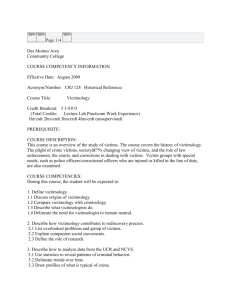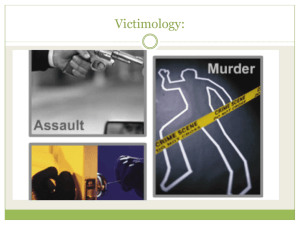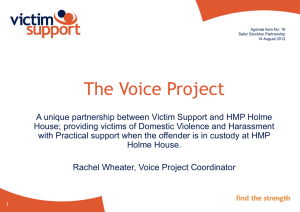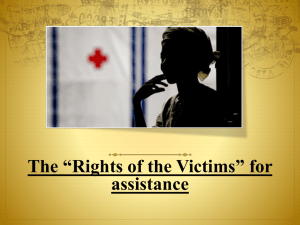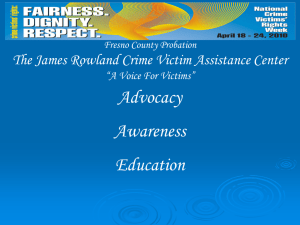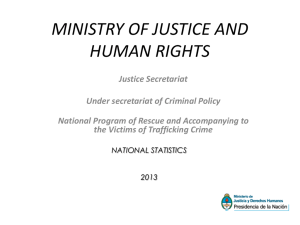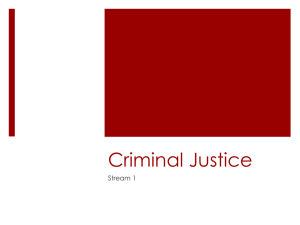SCOPE OF CONTEMPORARY VICTIMOLOGY
advertisement
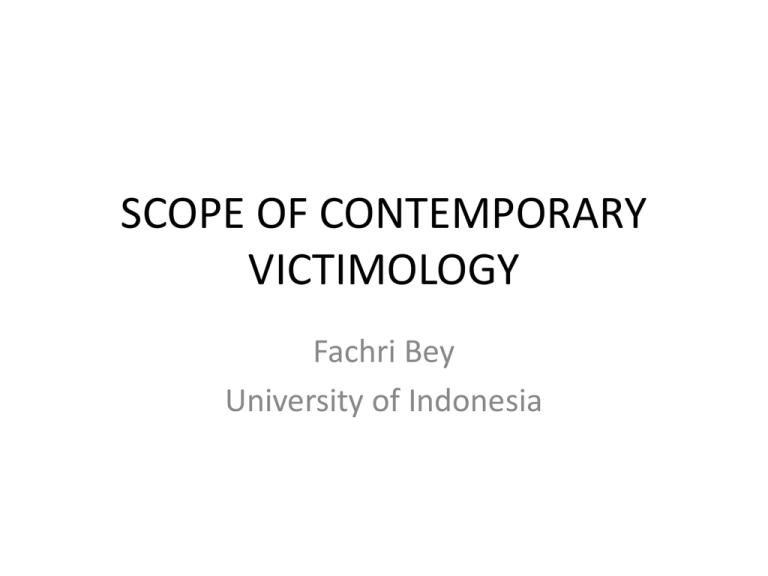
SCOPE OF CONTEMPORARY VICTIMOLOGY Fachri Bey University of Indonesia Victimology • Victimology as an academic terminology contains two elements : • One is the Latin word “ Victima” translates into “victim” • The other is the Greek word “logos” means a system of knowledge, the direction of something abstract, the direction of teaching, science, discipline. (Kirchhoff 2005-42) Cont. • Victims means a person harmed by a crime, tort, or other wrongful act . (Black Law Dictionary 1999) • Victims are persons threatened, injured or destroy by an act or omission of another man/structure, organization/institution. (Separovic, 1969) Victim of crime • Victims means persons who individually or collectively, have suffered harm, including physical or mental injury, emotional suffering, economic loss or substantial impairment of their fundamental rights, through acts or omissions that are in violation of criminal laws operative with in members state, including those laws proscribing criminal abuse of power.(UN Declaration 1985) • Formulation of the law, regulation, act thinking, are dedicated only to the offenders, about how guarantee their rights, how to educate/train them properly in correctional institution, how to protect their rights before the police officers, district attorney as well as in trial process before the judge • The public prosecutor/district attorney tend to be extremely careful in indicting the accused, in as much they are controlled frequently by the lawyer of the accused. • The rights of victims of crime have never been thinking seriously nor to provide them the proper and adequate treatment by the law enforcement authorities. • The victimologist in the past and in the present time come from different academic or professional background : from sociology, or from law, from psychiatry or from psychology, from social work and management. (Kirchhoff 1995-37) • Present time also come from medical doctor, environment, engineering, geology, biology, geophysics. • The lawyer of the offenders tend to (always) talk about the human rights protection of the offender wich render the public prosecutor feel uncertain. • The scope of contemporary victimology not only in criminal law and criminology field but has been developed to other fields as well. • Criminology – offender oriented • Victimology – victims oriented Victimology • Victimology as a growing discipline • Victimology is an independent area of inquiry or a sub field of Criminology • Victimology was born from its “mother” Criminology. • Historically, victimology bloomed in criminology. (Kirchhoff 1995-37). Conventional victims • • • • • • Victims of robery Victims of rape Victims of murder Victim of deception Victims of assault/batterey Victims of torture Inconventional victims • • • • • • • • Victims of technology Victims of Information Technology Victims of traffic accident Victim of aparheid Victims of slavery Victims of trafficking Victims of genocide Victims of crime against human right • • • • • • • • Victim of organized crime Victims of terrorism Victims of malpractice Victims of disaster Victims of abuse of power Victims of bullying Victims of child abuse & child neglect Victims of domestic violence Study of victim – offender systems • The study of victim vulnerability • The study of victim culpability • (Chockalingam 2010) Hans Von Hentig discovery • In his book 1948 : “ The Criminal and His Victim” he explained that increased attention should be paid to the crime provocative function of the victim…With through knowledge of the interrelation between the doer and the suffer, new approaches to the detection of crime will be opned. • Von Hentig believed that victim contribution largely results from characteristics or social positions beyond the control of the individual. Cont. • Thus Von Hentic classified victims into 13 categories depending on their prospensity for victimization. • 1. The Young – children and infant • 2. The female – All women • 3. The old – Elderly persons • 4. The mentallly defective and deranged- drug addicts -narcotic, alcoholic • 5. Immigrants – Foreigners unfamiliar with the culture • 6. Minorities – Racially • 7. The depressed Persons with various psychological maladies • 8. Dull normals – Simple-minded persons • 9. The Acquisitive – The greedy, those looking for quick gains • 10. The wanton – Promiscuous persons • 11. The losesome and heartbroken-widows, widowers, and those mourning • 12. The tormentor – An abusive parent • 13. The blocked, exempted or fighting-victims of blackmail, exortion, confidence games Beniamin Mendelsohn • Completely innocent victim- this victim type exhibited no provocative behavior prior to the offenders attack • Victim with minor guilt-victim due to ignorance did something in advertently that placed them in compromising positition before the occurrence of victimization. • Victim as guilty as the offender and voluntary victim, suicide cases and parties injures while engaging in vice crimes and other victimless offences Cont. • Victim more guilty than offender-propokes the criminal act. A person making an abusive remark would fit in here. A victim who started as an offender and, ended up as victim is the most guilty victim, e.g. the burglar shot by a house owner during an intrusion. • Simulating or imaginary victim, persons who pretend that they have veen victimized. A person who claims to have been mugged, rather than admitting to gambling his or her pay cheque away. Stephen Schafer • Revisited victim’s role in his book “The Victim and His Criminal” • The concept of functional resposibility of the victim. Schafer modified the typology by Hans von Hentig and presented his own classification. • While Hentig tried to identify the varying risk factors, Schafer sets forth the resposibility of different victims. General Victimology – A New Approach • Criminal victimization • Self-victimization include suicide and any other suffering induced by victims themselves • Victims of social environment incorporates individuals, class or group oppression, e.g. racial discrimination, caste relations, genocide and war atrocities. • Victims of Technology are people who fall prey to scientific innovation. Nuclear accidents, improperly tested medicines Cont. • Victims of natural environment people affected by floods, earthquakes, hurricanes. Critical Victimology • Mawby and Walklate (1994-21) define as • “An attempt to examine the wider social context in wich some versions of Victimology had become more dominant than others and also to understand how those versions of victimology are inter woven with question of policy response and service delivery to victims of crime” Cont. • Mawby and Walklate view that crime committed by the powerful are not subjected to the criminal court. • Genocide, war crimes, political campaign, clandestine ars sales and weapons of mass destruction, smuggling, and thehuman slave trade are not given serious attention. • Consequently, the victims of those crimes do not enter into the typical discussion of victimological concern. Others • • • • The women’s movement Children’s rights Victim Compensation Legal reform
